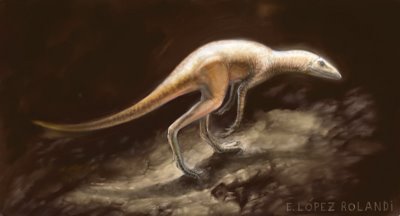 |
 |
 |
 |
 |
Produced
by the Population Genetics and Evolution class, Furman University |
||||
 |
 |
 |
 |
 |
Produced
by the Population Genetics and Evolution class, Furman University |
||||
 |
The
Triassic: Marasuchas and the Ornithodirans |
 |
||
| Ornithodira
is a subsection of the Archosauromorphs clade that contains the superorders
Dinosauromorpha and Pterosauromorpha. The defining features are an upright
gait and an S-curved neck, although the pterosauromorphs had neither of
these; they are nonetheless included because of Ornithodira’s definition
as being the last common ancestor of the dinosaurs and pterosaurs. The
latter of these are possibly the very first flying vertebrates, although
it is the former that is considered the progenitor of modern birds (Gauthier
1986). Marasuchus lilloensis, formerly Lagosuchus lilloensis,
is a single species in a genus created to differentiate between different
forelimb proportions of fossils. Both genera are the most likely ancestors
of the dinosaurs. Originally discovered in Argentina, M. lilloensis
measures approximately 40 cm in length. The morphology of its spine suggests
bipedal locomotion, a horizontal back, and an arched neck, and the long
tibiae and metatarsals may be adaptive to aid in running (Sereno and Arcucci
1994). Page by Will Towler |
 |
| Artist’s rendering of Marasuchus. Available from: blogspot.com | |
|
Gauthier J. 1986. Saurischian monophyly and the origin of birds. Memoirs California Academy of Sciences 8:1-55. Sereno PC, Arcucci AB. 1994. Dinosaurian precursors from the Middle Triassic of Argentina: Marasuchus lilloensis, gen. Journal of Vertebrate Paleontology 14:53-73. |